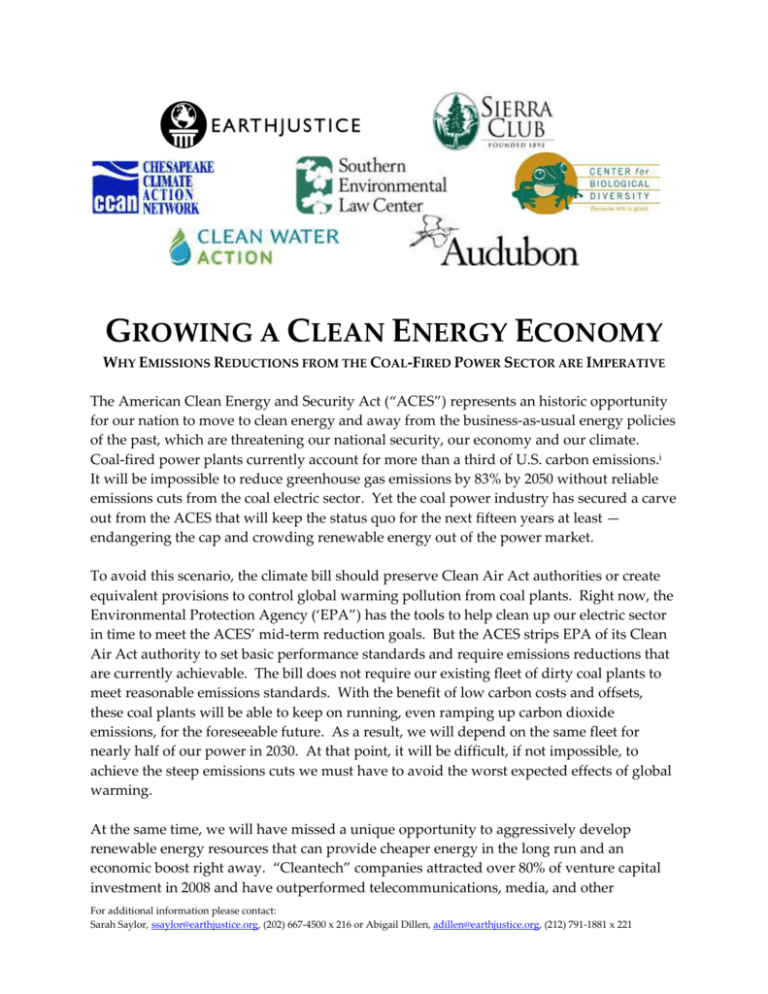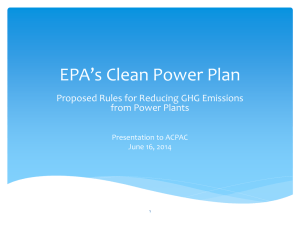THE NEED FOR COAL PLANT REGULATION TO COMPLEMENT
advertisement

GROWING A CLEAN ENERGY ECONOMY WHY EMISSIONS REDUCTIONS FROM THE COAL-FIRED POWER SECTOR ARE IMPERATIVE The American Clean Energy and Security Act (“ACES”) represents an historic opportunity for our nation to move to clean energy and away from the business-as-usual energy policies of the past, which are threatening our national security, our economy and our climate. Coal-fired power plants currently account for more than a third of U.S. carbon emissions.i It will be impossible to reduce greenhouse gas emissions by 83% by 2050 without reliable emissions cuts from the coal electric sector. Yet the coal power industry has secured a carve out from the ACES that will keep the status quo for the next fifteen years at least — endangering the cap and crowding renewable energy out of the power market. To avoid this scenario, the climate bill should preserve Clean Air Act authorities or create equivalent provisions to control global warming pollution from coal plants. Right now, the Environmental Protection Agency (‘EPA”) has the tools to help clean up our electric sector in time to meet the ACES’ mid-term reduction goals. But the ACES strips EPA of its Clean Air Act authority to set basic performance standards and require emissions reductions that are currently achievable. The bill does not require our existing fleet of dirty coal plants to meet reasonable emissions standards. With the benefit of low carbon costs and offsets, these coal plants will be able to keep on running, even ramping up carbon dioxide emissions, for the foreseeable future. As a result, we will depend on the same fleet for nearly half of our power in 2030. At that point, it will be difficult, if not impossible, to achieve the steep emissions cuts we must have to avoid the worst expected effects of global warming. At the same time, we will have missed a unique opportunity to aggressively develop renewable energy resources that can provide cheaper energy in the long run and an economic boost right away. “Cleantech” companies attracted over 80% of venture capital investment in 2008 and have outperformed telecommunications, media, and other For additional information please contact: Sarah Saylor, ssaylor@earthjustice.org, (202) 667-4500 x 216 or Abigail Dillen, adillen@earthjustice.org, (212) 791-1881 x 221 industries.ii Special favors for coal will slow the growth of this emerging industry and prevent the United States from becoming a global leader in the new clean energy economy. Grandfathering Old Coal Plants Under the law as it currently stands, EPA could enforce requirements under the Clean Air Act § 165 (NSR) and § 111(d) (NSPS for existing plants) to compel old coal plants to clean up or retire.iii However, the ACES waives these requirements and replaces them with a performance standard that applies only to new plants. Thus, existing plants are all “grandfathered,” meaning that they can run forever — and even expand their capacity — without installing carbon controls. Grandfathering has the unintended consequence of extending the life of existing plants instead of investing in renewables or new coal plants with CCS technology. This same perverse incentive has driven industry to keep running the oldest and dirtiest coal plants grandfathered under the Clean Air Act in 1977. While Congress assumed that these old plants would soon shut down or undertake retrofits, they have managed to avoid clean-up requirements for over thirty years with devastating pollution consequences. While new plants permitted after 2009 will be subject to performance standards in the ACES that will require them to cut emissions of carbon dioxide in half by 2025, the bill allows the entire fleet of existing plants to keep running without carbon controls. While all carbon dioxide sources of 25,000 tons per year or more will be subject to the overall emissions cap created in the ACES, free and cheap allowances and offsets iv will enable these grandfathered plants to keep operating for the foreseeable future.v EPA projects that only 6.9% of existing coal generation capacity will be retired by 2025, and most of this retired capacity will consist of “marginal units with low capacity.”vi By comparison, EPA projects that 58% of existing oil/gas capacity will be retired by 2025.vii In other words, coal will not be required to reduce emissions, and other sectors will be forced to pick up the slack. Stifling the Growth of a Clean Energy Economy With all of the incentives that the ACES provides to keep old coal plants running, EPA projects that we will still rely on coal to supply nearly half of our electricity in 2025.viii So long as coal dominates the power market, it will crowd out renewable energy. With coal generation remaining essentially flat through 2025 and electricity demand decreasing as a result of efficiency gains,ix investment in renewable energy and green jobs will falter. EPA projects that the ACES will result in 5% less growth in the wind and solar sector through 2025 as compared to baseline.x There is the potential to jumpstart the economy with a large-scale investment in renewable energy. If we fail to realize this potential, we face significantly higher electricity costs in the future. In the absence of a thriving renewable energy industry, EPA projects that compliance with the cap after 2030 will require massive expansion of nuclear and CCS coal capacity — the two most expensive energy sources available.xi Not surprisingly, EPA also projects spikes in consumer energy prices starting around 2030 under the ACES.xii Putting the Cap at Risk With old coal plants retaining the lion’s share of the power market, the ACES also puts the cap in jeopardy. Steady reductions in greenhouse gas emissions from the coal-fired electric sector are necessary to ensure compliance with the cap’s 2030 and 2050 targets. As a recent report by the Massachusetts Institute of Technology (“MIT”) makes clear, there is “no credible pathway toward GHG stabilization targets without emissions reductions from existing coal plants.”xiii Yet the ACES does not lay out a viable path to achieving those reductions. Weak near-term reduction targets invite the coal industry to defer major emissions reductions until the cap tightens in 2030.xiv Thus, EPA projects that 93% of today’s coal plants will still provide nearly half (45%) of our electricity in 2025, and only 9% of all coal plants will be using carbon capture and sequestration (“CCS”) technology to reduce their greenhouse gas emissions.xv This means that in 2025, we will be dependent on the same carbon-intensive power infrastructure that we have now, and when the cap tightens in 2030, we will not have the clean energy alternatives in place to make the dramatic reductions from our electric sector that are required. We know today that we need to transition away from existing plants to meet the 2030 and 2050 targets. Waiting fifteen years puts us on a crash course to burst the cap. Creating a Level Playing Field Closing the loopholes for coal plants in the ACES will ensure that this historic legislation delivers on its promise to offer real help in the national effort to fight global warming and promote clean energy alternatives. One way to do this would be to remove the Clean Air Act waivers in the bill. At a minimum, old coal plants, whether or not they decide to expand or rebuild, must be required to clean up on a reasonable and certain timeline, making sure they keep pace with modern technology. For example, a performance standard could be written to apply to existing plants on a graduated schedule as they age. And, if industry decides to invest in new capacity at old plants and increases greenhouse gas emissions they should be required to meet the same performance standards that are applicable to new plants. EIA, Emissions of Greenhouse Gases Report, Report #: DOE/EIA-0573(2007), “Total Emissions” & Table 11 (Dec. 3, 2008), http://www.eia.doe.gov/oiaf/1605/ggrpt/carbon.html#electric. ii The Pew Charitable Trusts, The Clean Energy Economy: Repowering Jobs, Businesses, and Investments Across America (June 2009), available at http://www.pewglobalwarming.org/cleanenergyeconomy/Clean_Energy_ Economy_Report.pdf.; National Venture Capital Association, CleanTech Advisory Council, “NVCA Recommendations to Obama Administration and new Congress on Energy Policy” (Dec. 11, 2008), available at http://www.nvca.org/index.php? option=com_content&view=article&id=90&Itemid=23;. Michael Burnham, N.Y. Times, June 10, 2009, available at http://www.nytimes.com/gwire/2009/06/10/10greenwire-green-jobs-sectorpoised-for-explosive-growth-63481.html. iii 42 U.S.C. §§ 7411(d), 7475. iv EPA Office of Atmospheric Programs, Analysis of the American Clean Energy and Security Act, H.R. 2454 in the 11 th Congress 12 (April 2009) (EPA is projecting carbon emission prices at $13 per ton in 2030 and $27 in 2040. By contrast, the European Union’s carbon market already prices emissions at over $20 per ton.). v Id. at 28 (concluding that “lower allowance prices and higher costs to build new technology make existing coal cost-competitive in the shorter-term”). vi Id. vii Id. viii EPA Report at 26. ix Id. x Id. at 27. xi Id. at 17. xii Id. at 19. xiii MIT Energy Initiative, Retrofitting of Coal-Fired Power Plants for CO2 Emissions Reductions 4 (March 23, 2009). xiv EPA Report at 11. xv Id. at 26-28. i For more information contact: Sarah Saylor, ssaylor@earthjustice.org, (202) 667-4500 x 216 or Abigail Dillen, adillen@earthjustice.org, (212) 791-1881 x 221









